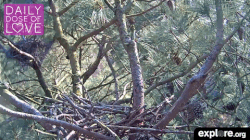Chesapeake Conservancy’s Wildlife Webcam Stars Return to Chesapeake, Now Streaming Live on Explore.org
Update: 3/25/17 Tom returned to the nest a few days after Audrey on 3/21/17.
Audrey (Osprey) Returns to Kent Island, Eastern Shore Great Blue Heron Rebuild Their Nests, and Baltimore City Peregrines Have 4 Eggs
Annapolis, MD – Spring in the Chesapeake means the return of iconic bird species and with that return, millions of viewers will tune in to watch the Chesapeake Conservancy’s wildlife webcams, streaming this year in proud partnership with explore.org, the world’s largest live camera network. Chesapeake Conservancy is pleased to begin a new season with explore.org and three live-streaming webcams that take viewers inside the nests of osprey, peregrine falcons, and great blue herons.

“When people think of the Chesapeake, they often think of some of its most iconic species, such as blue crabs, oysters, or osprey. We must not take for granted that these species depend on the health of the Chesapeake Bay for their very survival. In fact, both osprey and peregrine were brought back from the brink of extinction to once again thrive in the Chesapeake,” Chesapeake Conservancy President and CEO Joel Dunn said. “In a time of great turmoil for the Chesapeake, these beautiful birds provide an example of what we can do to restore the environment when we put our minds to it.”
Peregrine Falcon Cam
Viewers of the Baltimore Peregrine Falcon Nest Cam will see that stars Boh and Barb already have 4 eggs to take care of at their home in downtown Baltimore, on the 33rd floor of the Transamerica skyscraper. This building, located at 100 Light Street, has been a nesting site for peregrine falcons for over 35 years and has been a key component in the species’ recovery. Boh and Barb remain in Baltimore all through the winter, hunting birds such as pigeons, starlings, and jays.
Last season Boh and Barb hatched four eyases (falcon chicks) with three growing up to fledge in the fall. Fans voted to name the eyases Charlie, Pauli, and Pratt after the streets below the Transamerica Building.
Found on every continent except Antarctica, peregrine falcons (Falco peregrinus) are one of the best-known conservation success stories and are believed to be the fastest bird in the world, traveling up to 200 mph during hunts. These amazing birds have recovered from near eradication in eastern North America, now making many large cities and coastal areas their homes. After a drastic population decline from 1950-1970 due to pesticide poisoning, peregrine populations have rebounded due to a large-scale captive breeding and release program.
Osprey Cam
The Osprey Cam shows the daily lives of Tom and Audrey, an osprey couple living on Kent Island, at the home of the “Crazy Osprey Family.” Audrey returned to the nest on March 21, and she now awaits her mate, Tom. Last year, Tom and Audrey hatched two chicks, though a predator bird attacked the nest, knocking Audrey and one of the chicks off the nest. The surviving chick was named Chessie by webcam fans and successfully fledged in September.
In 2016, Tom and Audrey were featured in photo documentary entitled Inside an Osprey’s Nest. Authors Craig. A Koppie and Teena Ruark Gorrow photographed and documented the story of the osprey couple’s 2015 season, in which Koppie, a raptor biologist with the U.S. Fish and Wildlife Service, successfully introduced two foster chicks into the nest. The book is available on the Chesapeake Conservancy’s website. When purchased from this website, $10 will be donated to the Conservancy. Tom & Audrey’s fans also enjoy a blog written by the Crazy Osprey Family, a link is provided from the Conservancy’s website.
Found on every continent except Antarctica, osprey (Pandion haliaetus) are one of the Chesapeake’s most amazing birds for a number of reasons. They migrate thousands of miles each year to and from Central and South America, mate for life, and return to the same spot year after year, despite spending the winter apart from each other.
After an almost 90% decline in population from 1950-1970, osprey populations have rebounded due in large part to conservation efforts and the banning of DDT. Osprey can be a valuable indicator species for monitoring the long-term health of the Chesapeake Bay because their diet consists almost entirely of fish and they are sensitive to many environmental contaminants.
Great Blue Heron Cam
This week, great blue heron have started building up their nests at the great blue heron cam location. In 2016, the Chesapeake Conservancy launched its third webcam featuring a great blue heron rookery (colony) on the Eastern Shore through donations from fans to a GoFundMe campaign as well as sponsorship from Waterfowl Chesapeake. The property where the webcam is located hosts between 10 and 12 nests, with two of them in view of the camera. Featured heron couple Rell and Eddie hatched and fledged three chicks last year. Fans voted to name the chicks Felix, Lafayette and Moe.
According to the Chesapeake Bay Program’s website, great blue herons live in colonies called rookeries. These tall, bluish-gray wading birds have long, pointed bills and graceful, S-shaped necks. They live year-round in marshes and wetlands throughout the Chesapeake Bay region and are also found on freshwater lakes, ponds and impoundments. The great blue heron grows to 4 feet tall with a 6 to 7 foot wingspan. Despite its large size, its hollow bones allow it to weigh only 5 to 6 pounds. The great blue heron eats mostly fish, but will also feed on insects, amphibians, crustaceans and other small animals. It silently stalks its prey in shallow waters, and then plunges its bill into the water to capture it. It will spend about 90 percent of its waking hours hunting for food.
All three webcams can be viewed at
http://chesapeakeconservancy.o
Great Blue Heron Cam: explore.org/blueherons
Chesapeake Conservancy Osprey Cam: explore.org/ospreynest
Peregrine Falcon Cam: explore.org/falconcam